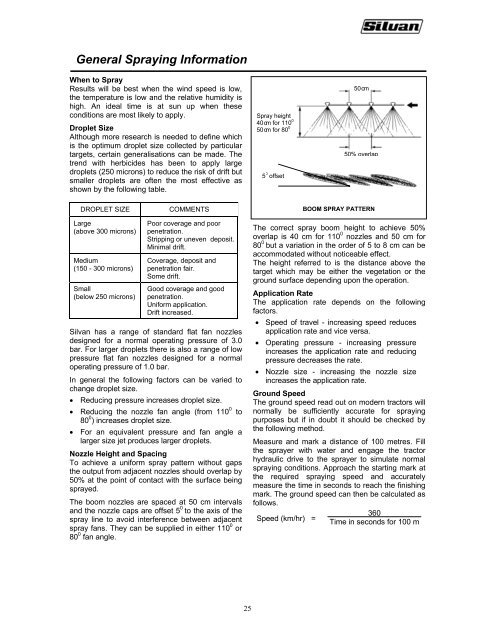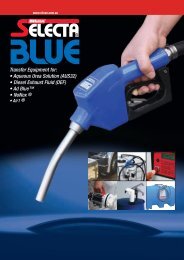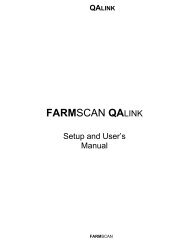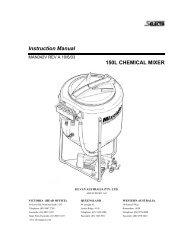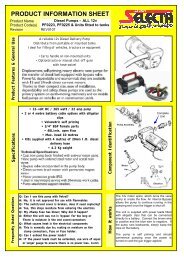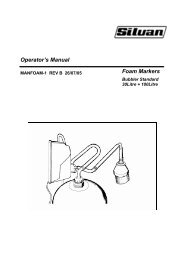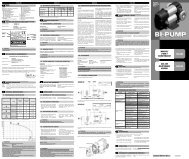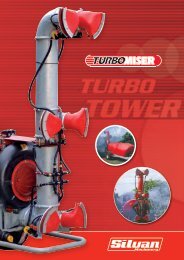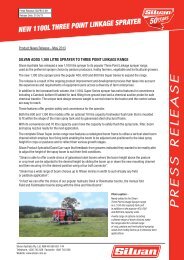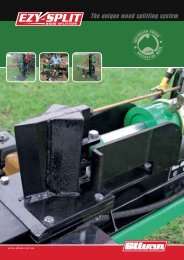Download Manual - Silvan Australia
Download Manual - Silvan Australia
Download Manual - Silvan Australia
You also want an ePaper? Increase the reach of your titles
YUMPU automatically turns print PDFs into web optimized ePapers that Google loves.
General Spraying Information<br />
When to Spray<br />
Results will be best when the wind speed is low,<br />
the temperature is low and the relative humidity is<br />
high. An ideal time is at sun up when these<br />
conditions are most likely to apply.<br />
Droplet Size<br />
Although more research is needed to define which<br />
is the optimum droplet size collected by particular<br />
targets, certain generalisations can be made. The<br />
trend with herbicides has been to apply large<br />
droplets (250 microns) to reduce the risk of drift but<br />
smaller droplets are often the most effective as<br />
shown by the following table.<br />
5 0 offset<br />
50 c m<br />
Spray height<br />
40 cm for 110 0<br />
50 cm for 80 0 50% overlap<br />
DROPLET SIZE<br />
COMMENTS<br />
BOOM SPRAY PATTERN<br />
Large<br />
(above 300 microns)<br />
Medium<br />
(150 - 300 microns)<br />
Small<br />
(below 250 microns)<br />
Poor coverage and poor<br />
penetration.<br />
Stripping or uneven deposit.<br />
Minimal drift.<br />
Coverage, deposit and<br />
penetration fair.<br />
Some drift.<br />
Good coverage and good<br />
penetration.<br />
Uniform application.<br />
Drift increased.<br />
<strong>Silvan</strong> has a range of standard flat fan nozzles<br />
designed for a normal operating pressure of 3.0<br />
bar. For larger droplets there is also a range of low<br />
pressure flat fan nozzles designed for a normal<br />
operating pressure of 1.0 bar.<br />
In general the following factors can be varied to<br />
change droplet size.<br />
• Reducing pressure increases droplet size.<br />
• Reducing the nozzle fan angle (from 110 0 to<br />
80 0 ) increases droplet size.<br />
• For an equivalent pressure and fan angle a<br />
larger size jet produces larger droplets.<br />
Nozzle Height and Spacing<br />
To achieve a uniform spray pattern without gaps<br />
the output from adjacent nozzles should overlap by<br />
50% at the point of contact with the surface being<br />
sprayed.<br />
The boom nozzles are spaced at 50 cm intervals<br />
and the nozzle caps are offset 5 0 to the axis of the<br />
spray line to avoid interference between adjacent<br />
spray fans. They can be supplied in either 110 0 or<br />
80 0 fan angle.<br />
The correct spray boom height to achieve 50%<br />
overlap is 40 cm for 110 0 nozzles and 50 cm for<br />
80 0 but a variation in the order of 5 to 8 cm can be<br />
accommodated without noticeable effect.<br />
The height referred to is the distance above the<br />
target which may be either the vegetation or the<br />
ground surface depending upon the operation.<br />
Application Rate<br />
The application rate depends on the following<br />
factors.<br />
• Speed of travel - increasing speed reduces<br />
application rate and vice versa.<br />
• Operating pressure - increasing pressure<br />
increases the application rate and reducing<br />
pressure decreases the rate.<br />
• Nozzle size - increasing the nozzle size<br />
increases the application rate.<br />
Ground Speed<br />
The ground speed read out on modern tractors will<br />
normally be sufficiently accurate for spraying<br />
purposes but if in doubt it should be checked by<br />
the following method.<br />
Measure and mark a distance of 100 metres. Fill<br />
the sprayer with water and engage the tractor<br />
hydraulic drive to the sprayer to simulate normal<br />
spraying conditions. Approach the starting mark at<br />
the required spraying speed and accurately<br />
measure the time in seconds to reach the finishing<br />
mark. The ground speed can then be calculated as<br />
follows.<br />
360<br />
Speed (km/hr) =<br />
Time in seconds for 100 m<br />
25


